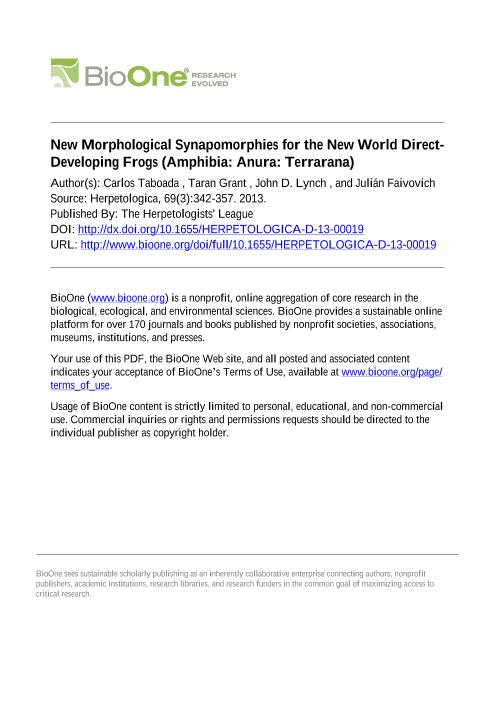Mostrar el registro sencillo del ítem
dc.contributor.author
Taboada, Carlos Alberto

dc.contributor.author
Grant, Taran
dc.contributor.author
Lynch, John D.
dc.contributor.author
Faivovich, Julián

dc.date.available
2016-02-04T14:39:27Z
dc.date.issued
2013-09
dc.identifier.citation
Taboada, Carlos Alberto; Grant, Taran; Lynch, John D.; Faivovich, Julián; New morphological synapomorphies for the new world direct-developing frogs (Amphibia: Anura: Terrarana).; Herpetologists League; Herpetologica; 69; 3; 9-2013; 342-357
dc.identifier.issn
0018-0831
dc.identifier.uri
http://hdl.handle.net/11336/4023
dc.description.abstract
The New World direct-developing frogs (Terrarana) comprise more than 970 species distributed from the southern United States to northern Argentina. Although the composition of this clade has been remarkably stable for many decades, evidence for its monophyly is derived mostly from DNA sequences with putative phenotypic synapomorphies limited to the occurrence of direct development, an embryonic egg tooth (known in few species), and T-shaped terminal phalanges. Based on a survey of the burogenital and vascular systems and the submandibular musculature of hyloid frogs, we report 16 characters that provide putative synapomorphies at a variety of hierarchic levels. Most significantly, they include seven putative synapomorphies for Terrarana that can be observed through simple dissections, including (1) fusion of the Wolffian ducts, resulting in a single, common cloacal opening; (2) Wolffian duct fusion located anteriorly with a single, common duct along the posterior, . 1/3 of the distance between caudal edge of kidneys and cloacal wall; (3) presence of the posterior dorsolumbar vein; (4) absence of the medial dorsolumbar vein; (5) origin of the posterior caval vein in the anterior 1/3 of the kidneys; (6) posterior origin of dorsolumbar arteries; and (7) presence of the pelvic lymphatic septum.
dc.format
application/pdf
dc.language.iso
eng
dc.publisher
Herpetologists League

dc.rights
info:eu-repo/semantics/openAccess
dc.rights.uri
https://creativecommons.org/licenses/by-nc-nd/2.5/ar/
dc.subject
Terrarana
dc.subject
Brachycephalidae
dc.subject
Urogenital Morphology
dc.subject
Synapomorphies
dc.subject
Vascular System
dc.subject
Submandibular Musculature
dc.subject
Systematics
dc.subject.classification
Zoología, Ornitología, Entomología, Etología

dc.subject.classification
Ciencias Biológicas

dc.subject.classification
CIENCIAS NATURALES Y EXACTAS

dc.title
New morphological synapomorphies for the new world direct-developing frogs (Amphibia: Anura: Terrarana).
dc.type
info:eu-repo/semantics/article
dc.type
info:ar-repo/semantics/artículo
dc.type
info:eu-repo/semantics/publishedVersion
dc.date.updated
2016-03-30 10:35:44.97925-03
dc.journal.volume
69
dc.journal.number
3
dc.journal.pagination
342-357
dc.journal.pais
Estados Unidos

dc.journal.ciudad
Lawrence
dc.description.fil
Fil: Taboada, Carlos Alberto. Consejo Nacional de Investigaciones Científicas y Técnicas. Oficina de Coordinación Administrativa Parque Centenario. Museo Argentino de Ciencias Naturales; Argentina
dc.description.fil
Fil: Grant, Taran. Universidade de Sao Paulo. Instituto de Biôciencias; Brasil
dc.description.fil
Fil: Lynch, John D.. Universidad Nacional de Colombia. Instituto de Ciencias Naturales; Colombia
dc.description.fil
Fil: Faivovich, Julián. Consejo Nacional de Investigaciones Científicas y Técnicas. Oficina de Coordinación Administrativa Parque Centenario. Museo Argentino de Ciencias Naturales; Argentina
dc.journal.title
Herpetologica

dc.relation.alternativeid
info:eu-repo/semantics/altIdentifier/doi/10.1655/HERPETOLOGICA-D-13-00019
dc.relation.alternativeid
info:eu-repo/semantics/altIdentifier/url/http://www.bioone.org/doi/full/10.1655/HERPETOLOGICA-D-13-00019
dc.relation.alternativeid
info:eu-repo/semantics/altIdentifier/doi/http://dx.doi.org/10.1655/HERPETOLOGICA-D-13-00019
Archivos asociados
